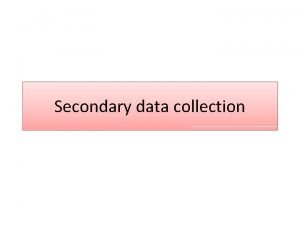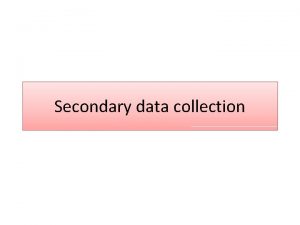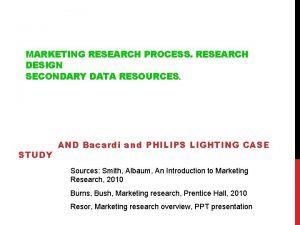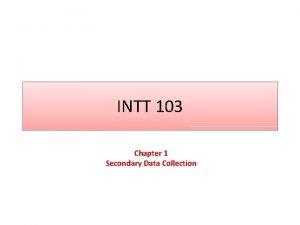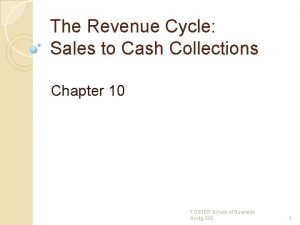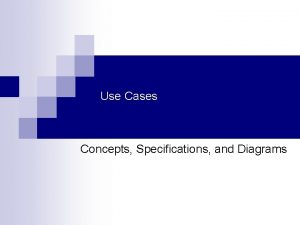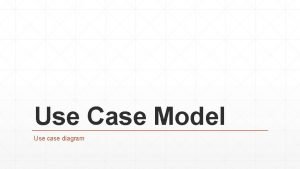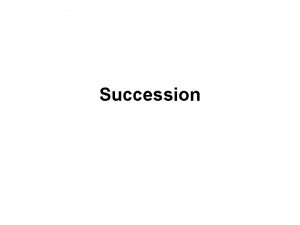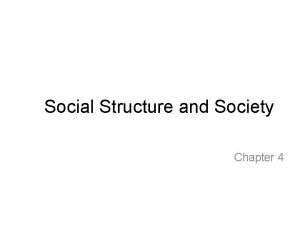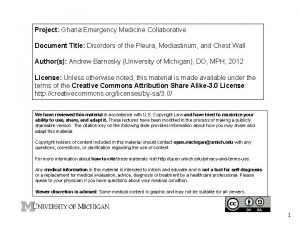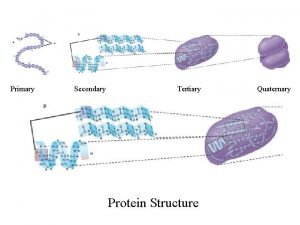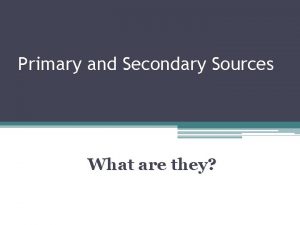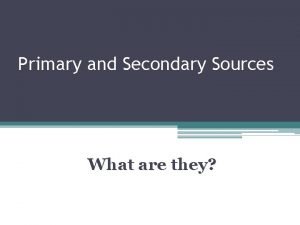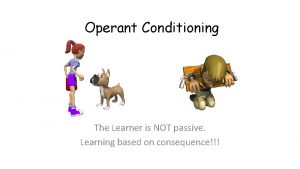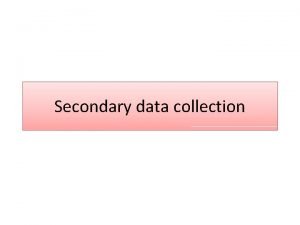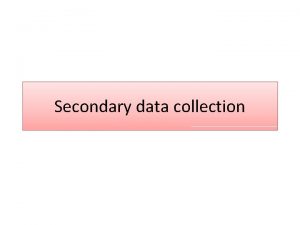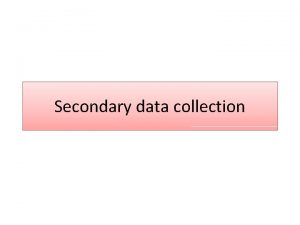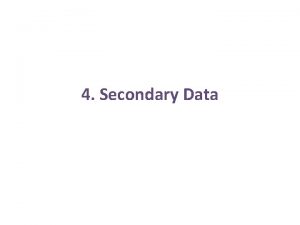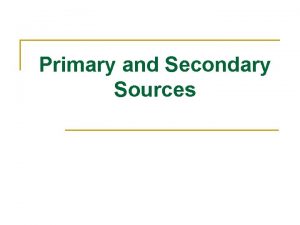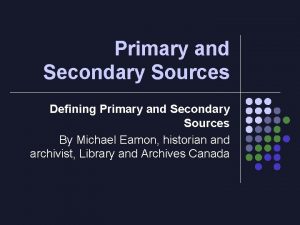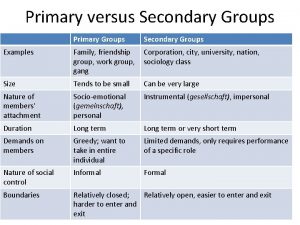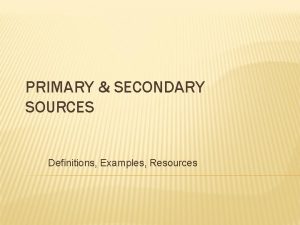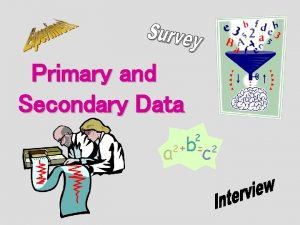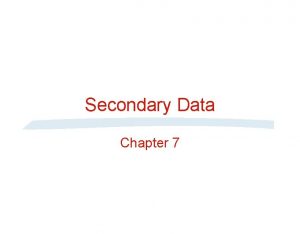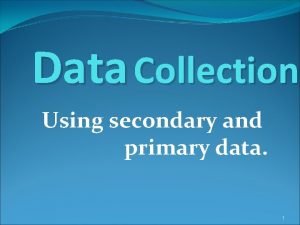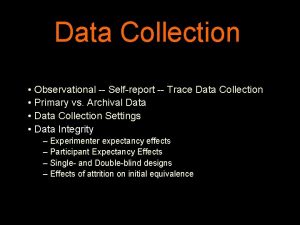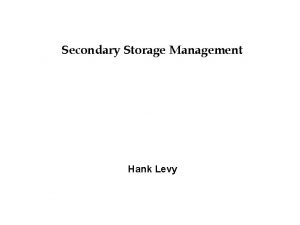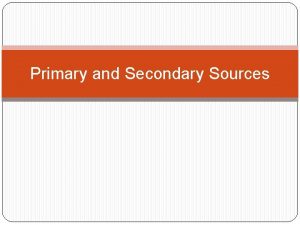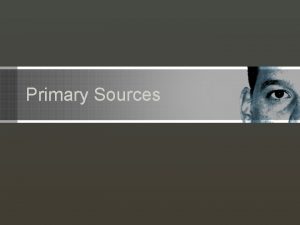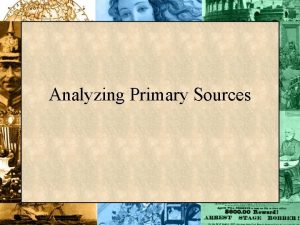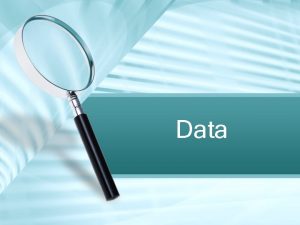DATA COLLECTION PRIMARY DATA SECONDARY DATA PRIMARY DATA

















































- Slides: 49

DATA COLLECTION • PRIMARY DATA • SECONDARY DATA PRIMARY DATA: The Primary data are those which are collected afresh and for the first time and thus happen to be original in character

COLLECTION OF PRIMARY DATA Ø SURVEY &DESCRIPTIVE RESEARCH üOBSERVATION METHOD üINTERVIEW METHOD üQUESTIONAIRE METHOD üTHROUGH SCHEDULES üOTHER METHODS

OTHER METHODS OF PRIMARY DATA COLLECTION a) b) c) d) e) f) g) h) WARRANTY CARDS DISTRIBUTOR AUDITS PANTRY AUDITS CONSUMER PANELS USING MECHANICAL DEVICES THROUGH PROJECTIVE TECHNIQUES DEPTH INTERVIEWS CONTENT ANALYSIS

OBSERVATION METHOD Observation involves viewing and recording individuals, groups, organizations or events in a scientific manner in order to collect valuable data related to the topic under study. ADVANTAGES: ØSubjective bias is eliminated ØCurrent data ØIndependent of the respondents willingness

Limitations Expensive Information is very limited Unforseen factors interfere Method format: �Standardized and structured Descriptive (eg. , To record the appeal of the toy for a child) �Non-standardized and unstructured Exploratory ( eg. , Consumer experiences at service location)

OBSERVATION METHOD Level of respondent consciousness �Disguised observation (Intangible aspect of human behaviour) �Undisguised observation (GD or formal meeting) Observation based on setting �Natural environment (eg: interaction of employees during break �Simulated environment (eg: armed forces stress test are carried to measure individual tolerance) Role of the human participant �Participating �Non-participating

Mechanical observation method �Store scanners and store cameras �Audio and people meters �Psycho galvanometer �Oculometers �Pupilometers �Voice pitch meters

Personal interview method The personal interview is a one to one interaction between the investigator/interviewer and the interviewee. The purpose of the dialogue is research specific and ranges from completely unstructured to highly structured Typical Usage: • Problem definition • Exploratory research • Primary data collection

Conducting the personal interview • Stating the interview objective • Identifying the interview guidelines: unstructured, semi-structured or structured. • Screening the interviewees • Analysis and interpretation of interview data

Categorization of Personal Interview

Categorization of Personal Interview • Personal methods: these include at-home interviews, mall-intercept interviews, computer assisted personal interviews. • Telephone methods: these include traditional telephonic interviews, computer assisted telephonic interviews.

Increasing participation • The interviewer should introduce himself by name and the organizations to which they are affiliated to. • If the participant is busy, the interviewer should try to stimulate interest so as to arrange for an interview at another time. • The successful conduct of interview requires a good rapport and understanding between the interviewer and participant. • In the process of gathering data the interviewer should ensure that the objective of each question is achieved and the needed response is obtained. The interviewer can resort to probing, but steps should be taken to avoid the bias. • The interviewer should record the answers of the participant in an efficient manner.

• Interviewers should have good communication skills, should be able to adapt to flexible schedules, be willing to work during intermittent work hours and should be mobile. • Questioning techniques should be followed by the interviewer. Funneling approach can be practiced

Problems in conducting personal interview • • Sampling error Non response error (Probability sampling) Response error Cost

• Advantages and drawbacks • The major advantage of personal interviewing is the ability to secure in-depth information and detail. The ability to harness information is more in personal interviewing as compared to telephone, mail survey and through internet. • The researcher can adopt the questioning technique in tune with the respondent’s ability to understand. Further clarification can be immediately made by repeating or rephrasing the questions concerned. • The researcher can also get information from the nonverbal clues exhibited through the body language of the respondent.

Sample interview Guide S

Conduct an interview to obtain info about : • • • Demographics Psychographics Lifestyle Role models Friends- the relevance of friendship in a person specifically his/her life What are the qualities he/she looks for in a friend?

• Describe his /her friendship group. • Analyse himself/herself in terms of kind of friends he/she is? • In this respect if she/he could improve on his /her one quality, what would it be ? • A story or a song he/ she associates with true friendship.

Questionnaires • Questionnaires The basic requirement for a questionnaire is that spelt-out research objectives must be converted into clear questions.

• A. Personally administered questionnaire • If the study is confined to a local area, the questionnaires can be collected by personally administering the same. The main advantage is that the researcher can collect all the completed responses within a short period of time. • Administering the questionnaire to a large number of respondents at a time would save time and expenses and also ensure quick collection of data as against personal interviewing. • The major drawback will be the reluctance of organizations to give time to conduct survey among group of employees.

• B. Mail questionnaire • Where the respondents are scattered over a wide geographical area, the researcher has to resort to mail questionnaires. The questionnaires are mailed to the respondents, who can complete them at their convenience, in their home at their own pace. • The main advantage is that the anonymity of respondents is maintained and this will lead to a free and frank disclosure of information. The respondents spread over a wide , geographical area can be reached and the respondents can take more time at their convenience and fill the questionnaire. It can also be administered electronically. • However, the return rates of mail questionnaires are typically low. The doubts in the questionnaire cannot be cleared as easily as in the case of personally administered questionnaire. The representativeness of the sample is questionable due to the low return rates.

• Guidelines for questionnaire design • A good questionnaire accomplishes the research objectives. The logical sequences of the steps involved in the development of a good questionnaire are discussed below: • I. Deciding the information to be collected • II. Formulate the questions needed to obtain the information • III. Decide on the wordings of the questions and layout of the questionnaire • IV. Pretesting the questionnaire and correcting the problem

I. Deciding the info to be collected • The researcher should have a clear idea of exactly what information is to be collected from each respondent. Lack of clarity will lead to collection of irrelevant and incomplete information which does not contribute towards the research purpose. The situation will diminish the value of the study. Clarity can be facilitated by, • Clear research objectives that will provide an insight into the kind of information needed, the hypotheses and the scope of the research • Exploratory research will reveal the variables to be explored and will enable to understand the point of view of the respondents • Experience with similar studies • Pretesting the preliminary version of the questionnaire

• In deciding the content of the questionnaire the following guiding factors should be considered: • The question may be asked to get information regarding objective or subjective variables or both. • In the case of objective variables like age, gender, income etc a single direct question can be asked. However, if the question is regarding subjective variable for eg. , regarding attitude, feeling, satisfaction etc then the questions should tap the dimensions and elements of the concept concerned. • The question should ask precisely what is needed. For e. g. , if the researcher needs to know the ‘family income’ of the respondent but the question is asked regarding ‘income’ then it may mean to the respondent as the respondents’ income and not family income. Unambiguous words can be used so that clarity can be ensured.

II. Formulate the questions 1. 2. 3. 4. 5. 6. 7. 8. Open-ended questions Dichotomous questions Multiple choice questions Checklist questions Ranking questions Positively and negatively worded questions Double-barreled questions Ambiguous question

9. Memory related questions 10. Leading / Loaded questions 11. Bad questions

1. Open ended questions: � What is your age? � How would you evaluate the work done by the present government? � How much orange juice does this bottle contain? � What is your reaction to this new custard powder? � Why do you smoke Gold Flake cigarettes? � Which is your favorite TV serial? � What training programme have you last attended? � With whom in your work group do you interact with after office hours?

Closed ended questions 2. Dichotomous questions � Are you diabetic? � Have you read the new book by Dan Brown? � What kind of petrol do you use in your car? Yes / No Yes/no Normal/Premium � What kind of cola do you drink? Normal/diet � Your working hours in the organization are fixed/ flexible

3. Multiple choice questions � How much do you spend on grocery products (average in one month)? - Less than Rs. 2500/- Between Rs 2500 -5000/- More than Rs 5000/- 4 4. Check list questions Checklist questions are used when the researcher wants the respondent to give multiple responses to a single question. For e. g. , the factors leading to the choice of a particular brand laptop.

5. Ranking questions • Ranking question is used when the response regarding the relative order of the alternatives are important. • The ranking question will lead the respondent to rank the most important factor as ‘ 1’ the next important as ‘ 2’ and so on. 6. Positively and negatively worded questions • The questionnaire should include both positively and negatively worded questions. If all the questions are positively worded then the respondent will tend to mechanically circle all the points toward one end of the scale. • The use of double negatives and excessive use of words such as ‘not’ , ‘only’ etc. , should be avoided in the negatively worded question as they will tend to confuse the respondents

7. Double-barreled question. A question that leads to different possible responses to its sub-parts is called a double-barreled question. Such questions should be avoided by way of breaking the questions into two or more parts. -Eg: Are you satisfied with the salary and increments given? The question may lead to ambiguous reply. 8. Ambiguous question • The question may not be double-barreled but still it may lead to ambiguity. • For e. g. , if the researcher involved in the study of the job satisfaction asks the respondent to rate the level of satisfaction, the respondent may be confused as to whether the question is addressing satisfaction related to work environment, salary, team spirit or overall satisfaction.

9. Memory related questions • If the questions require respondents to recall experiences from a distance past that are very hazy in their memory, then the answers to such question might be biased. 10. Leading / Loaded questions • Questions should not be asked in such a way that the respondents are forced or directed to respond in a manner that he would not have, under normal situations where all possible alternatives are given. • For example, "Don’t you think that salary is the main reason for software employees to quit the job"? . Questions which are emotionally charging the respondents are called as loaded questions.

• 11. Bad questions • Any question that prevent or disturbs the fundamental communication between the researcher and the respondent is considered to be a bad question. • Some examples of the bad questions are incomprehensible questions, unanswerable question, leading or loaded questions, doublebarreled question etc.

III. Decide on the wordings of the questions • The basic component of a questionnaire is the words. • The researcher should be careful in considering the words to be used in creating the questions and scales for collecting raw data from respondents.

• The vocabulary should be simple, direct and familiar to all respondents. • The words used should not give raise to ambiguity or vagueness. This problem arises because of not giving the respondent an adequate frame of reference , in time and space for interpreting the question. • Eg: Usage of words Often, Usually lack an appropriate time

• Double-barreled question should be avoided Eg: Are you satisfied with the salary and increments given? • The instructions provided to answer the question should not be confusing the respondent. • Simple short questions should be asked instead of long ones

• Questions should not be asked in such a manner that it will elicit socially desirable response. Eg: Will you take dowry when you get married ? (incorrect) Do you think most indian men would take dowry when they get married? (correct)

Layout of the questionaire • In the introduction section, the researcher can disclose his identity and communicate the purpose of the research. • The questions should be organized in a logical manner and numbered sequentially under appropriate sections. • Questions relating to the personal profile of the respondents • The open ended questions should be put at the end so the respondent may find it easy to comment on the various aspects. • The questionnaire should end with an expression of sincere thanks to the respondent for spending their valuable time and effort.

iv. Pretesting the questionnaire • The purpose of a pretest is to ensure that the questionnaire meets the researcher’s expectations in terms of the information to be obtained. The objective of the pretest is to identify and correct the deficiencies in the questionnaire.

Type of pretesting • researcher pretesting • Participant pretesting (field) • Collaborative pretest (where the researcher informs or alerts the participants of their involvement in the preliminary test of questionnaire. ) • Non-collaborative pretest (researcher does not inform the participant that the activity is a pretest. )

Reason for conducting pretest • to know whether the meaning of the questions is interrupted in the manner in which it is intended to. • Flow of the questionnaire should be tested • Many questionnaires have instructions on what question to skip, depending on the answer to a previous question. • The length of the questionnaire is pretested

• Task difficulty should also be identified through pretest. For e. g. , questions related to annual income.

Secondary data • Data which is already available and analysed by someone else. When researcher uses this data he has to look into various sources from where he obtain them. It can be published and unpublished. Published data includes • Various publication of central, state and local governments • Various publication of foreign government or international bodies • Technical and trade journals

• Books , magazines and newspapers • Reports and publication of various association connected with business and industry , banks, stock exchanges etc • Reports prepared by research scholars, universities, economists etc. , in different fields • Public records and statistics, historical documents and other sources of published information

Unpublised Secondary data • • Diaries Letters Unpublised biographics and auto biographics Scholars and research workers Trade associations, Labour bureaus Other public/private individuals and organisation.

Government publications

Government publications (contd. )

Non-government publications

Non-government publications (contd)
 What is primary data
What is primary data Data collection secondary data sources
Data collection secondary data sources Attitudinal question
Attitudinal question Primary data and secondary data
Primary data and secondary data Primary and secondary data
Primary and secondary data Primary data and secondary data
Primary data and secondary data What is primary data
What is primary data Landsat collection 1 vs collection 2
Landsat collection 1 vs collection 2 D/a 30 days after sight
D/a 30 days after sight A major advantage of primary data collection is
A major advantage of primary data collection is The primary objective in cash collection is to:
The primary objective in cash collection is to: Data collection procedure and data analysis
Data collection procedure and data analysis Primary and secondary effects of a tectonic hazard
Primary and secondary effects of a tectonic hazard Primary and secondary stakeholders
Primary and secondary stakeholders Planting more trees is called
Planting more trees is called Primary volcanic hazards
Primary volcanic hazards Wastewater treatment process primary secondary tertiary
Wastewater treatment process primary secondary tertiary Use case primary and secondary actors
Use case primary and secondary actors Pengertian include dan extend
Pengertian include dan extend Why transformer is called static device
Why transformer is called static device Secondary storage vs primary storage
Secondary storage vs primary storage Xylem
Xylem Primary and secondary hyperthyroidism
Primary and secondary hyperthyroidism Causes of primary hypothyroidism
Causes of primary hypothyroidism Primary control vs secondary control
Primary control vs secondary control Primary and secondary retroperitoneal organs
Primary and secondary retroperitoneal organs What colors are located next to each other on the wheel
What colors are located next to each other on the wheel Difference between primary and secondary succesion
Difference between primary and secondary succesion Primary alcohol vs secondary alcohol
Primary alcohol vs secondary alcohol Primary storage and secondary storage
Primary storage and secondary storage Difference between primary secondary and tertiary alcohols
Difference between primary secondary and tertiary alcohols Purpose of project planning
Purpose of project planning Agents of socialization
Agents of socialization Primary and secondary deviance
Primary and secondary deviance Ravine erosion
Ravine erosion Bronchiole
Bronchiole Lights criteria
Lights criteria Secondary sources
Secondary sources Primary evidence vs secondary evidence
Primary evidence vs secondary evidence What is secondary tillage
What is secondary tillage Primary and secondary tertiary sources
Primary and secondary tertiary sources Primary secondary tertiary
Primary secondary tertiary Autobiography is a primary source
Autobiography is a primary source Autobiography using primary sources
Autobiography using primary sources Primary evidence vs secondary evidence
Primary evidence vs secondary evidence Primary evidence vs secondary evidence
Primary evidence vs secondary evidence Autobiography is a primary source
Autobiography is a primary source Secondary source of light
Secondary source of light Ukraine preschool
Ukraine preschool Positive reinforcement vs negative reinforcement
Positive reinforcement vs negative reinforcement
